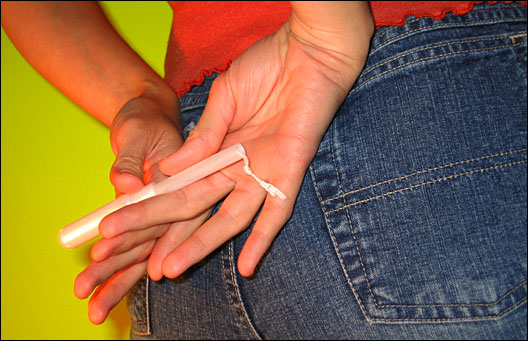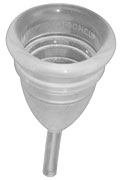
Editor’s note: This is the second of a two-part series on feminine products. The first column focused on sanitary pads.
In a rant about her angry vagina, author Eve Ensler famously described tampons as “a dry wad of fucking cotton” — and she ain’t far from the truth.
Unfortunately, she left out a key detail: Most tampons are made from rayon-cotton blends — an important distinction, because rayon is often chlorine-bleached, a process that releases the cancer-causing chemical dioxin. This toxin builds up in fatty tissue and has been linked to endometriosis, immune-system suppression, and other health problems. Since it’s in a product intended for our, ahem, most intimate of locations, there’s definitely another reason to be angry.
Grist’s Pick
The Keeper
Some companies offer tampons made of organic cotton, which is progress, and we’ve reviewed a few brands below. But tampons still pose a burden on the waste stream and the risk of toxic shock syndrome, so we’ve also looked at the alternative that addresses these issues: the menstrual cup.
Deemed the “official menstrual product of the revolution” by one of the Grist Lady Feminine Product Reviewers, these reusable latex or silicone cups are arguably the most environmentally friendly of all the options out there, edging out their reusable sanitary-pad equivalents (GladRags and Lunapads) for the sheer fact that they require less water to clean. (And, in a pinch, aka “a public-bathroom situation,” they can be wiped clean with toilet paper.) Retailing at about $35, they require a little cash up front, but are a far more affordable option than disposables over time.
We asked the GLFPR to consider both the menstrual cups and several organic cotton tampon options, because there isn’t a universal “right answer” when it comes to such a personal decision. Here’s what they had to say.

The Keeper
Eco-claims: Made from natural gum rubber (latex); reusable for up to 10 years
Capacity/Length of use: One ounce; on heavy days, about three hours; on light days, all day; comes in two sizes (before- and after-childbirth)
Leakage: Minimal, even after strenuous physical activity
Odor: Detectable only when emptying; the Keeper itself began to smell when wet after about eight years
Comfort: If properly inserted, you shouldn’t be able to feel it at all
The Keeper is well-loved among the product-reviewing pool — not to mention by Umbra Fisk — with one reviewer having been a devoted user since 1994. The Keeper, like all the menstrual cups, is wider than the average tampon, which can lead to concerns about getting it in and out. But according to one reviewer, what the Keeper lacks in comfort, it more than makes up for in terms of convenience, smell containment, and panty protection. Even while playing physically demanding sports, the Keeper holds up, she says, “unlike tampons, where it seemed like that stupid string acted as a firefighter’s pole straight to my undies.”

The Moon Cup
Eco-claims: Made from non-latex, medical-grade silicone; reusable for up to 10 years
Capacity/Length of use: One ounce; on heavy days, about three hours; on light days, all day; comes in two sizes (before- and after-childbirth)
Leakage: Minimal, though somewhat dependent on how skillful you are at inserting it
Odor: Detectable only when emptying
Comfort: If properly inserted, you shouldn’t be able to feel it at all
The Moon Cup is identical to the Keeper, but made from silicone for the latex-averse or -allergic. It also has a longer stem than the Diva Cup or the Keeper, but it’s OK to trim it to a length that is comfortable. One reviewer, who was new to menstrual cups in general, said it took her a decent amount of practice to get the Moon Cup correctly in place and learn how to remove it properly. She also said that the more she used it, the more comfortable it became, though for her it was never entirely unnoticeable. Another particularly unfortunate Moon Cup tester got her first UTI while using the product, which should serve as a cleanliness cautionary tale for all menstrual-cup users.

Diva Cup
Eco-claims: Made from non-latex, medical-grade silicone; reusable for up to 10 years
Capacity/Length of use: One ounce; on heavy days, about three hours; on light days, all day; comes in two sizes (before- and after-childbirth)
Leakage: Minimal, even after strenuous physical activity — so long as the product is the proper size and inserted correctly
Odor: Detectable only when emptying
Comfort: If properly inserted, you shouldn’t be able to feel it at all
One reviewer swears by the Diva Cup, having used it for years without any leakage, despite leaving it in for long days and strenuous athletic endeavors. But two others have had leakage problems related to sizing issues: One, the mother of an adorable daughter, says the post-childbirth Diva Cup has never quite fit correctly, leading to leakage as well as discomfort. The other is sans tot, but followed the website’s directions to purchase the larger size because she is over 30. For her, the product was a “complete failure” — difficult to insert and remove, highly uncomfortable to leave in, and a leakage problem, to boot. She reckons her petite frame puts her in the minority of 30-plus women who should use the smaller size — but she doesn’t want to risk another “pricy disappointment.”

Sea Pearls
Eco-claims: Natural, reusable, sustainably harvested Atlantic sea sponge tampons; dioxin- and rayon-free
Capacity/Length of use: Up to eight hours, depending on flow; need to be completely replaced every six months
Leakage: None
Odor: None
Comfort: “More comfortable than tampons”
Though these sponges got positive reviews for their comfort, reusability, and absorptive power, they lost major points on ease of use and practicality. The sponges come without an “extraction line,” so removal can be messy; the packaging suggests adding a cotton string or waxed dental floss if needed. More than this, though, is the problematic nature of needing to rinse the sponge before reuse. For women away from home, a small plastic baggie may be needed to carry the used sponges until they can be properly disinfected. Said one reviewer, “The cute carrying case [that comes with the product] is completely useless beyond a double-life as a potpourri sachet.” After one adventurous reviewer took the company at its word and attempted certain bedroom activities with a sponge in, she found that it had shifted, and had this advice: “Don’t try it unless you have quite a reach.”

Natracare Organic All Cotton Tampons
Eco-claims: Made of 100 percent certified organic cotton; free of synthetic materials, like rayon, and chemical additives; non-chlorine bleached
Capacity/Length of use: Up to eight hours, varies depending on flow
Leakage: None
Odor: None
Comfort: Can’t feel it
A former o.b. user found no major difference between these organic cotton, non-chlorine-bleached tampons and their mainstream dioxin-laced brethren. The self-described “zealous tampon connoisseur” said she even — gasp! — exceeded the recommended hour limit on the box, but remained leak-free. Said another reviewer, “If there’s one cotton product you’d want to be organic, it’s a tampon. A good, solid choice.” The only complaint came from a user who chose the applicator version and had problems with the cardboard pieces sticking together.

Seventh Generation Chlorine-Free Organic Cotton Tampons
Eco-claims: Made of 100 percent certified organic cotton; free of synthetic materials, like rayon, and chemical additives; non-chlorine bleached
Capacity/Length of use: Up to eight hours, varies depending on flow
Leakage: None
Odor: None
Comfort: Can’t feel it
Much like their Natracare counterparts, Seventh Generation tampons met all expectations for a proper regular-strength tampon: no leaks, no comfort issues, no product malfunctions. One reviewer pointed out that they even have elegant minimalist packaging: inside the 100 percent recycled-paper box, each tampon is individually shrink-wrapped in clear plastic, with just a simple stripe to indicate where to tear the wrapping. Curiously, the Natracare tampons have that same little stripe. Upon further investigation, it turns out both brands source their tampons from an organic sanitary-products manufacturer in Germany. The same organic tampon? Ich weiß nicht.
The bottom line: The menstrual cup is arguably the most eco-friendly of all the feminine-product options, and the Keeper seemed to be the favorite of the three tested for this column. For all you soon-to-be Keeper-converts wondering what you’ll do with your leftover tampons, we recommend arts and crafts.

